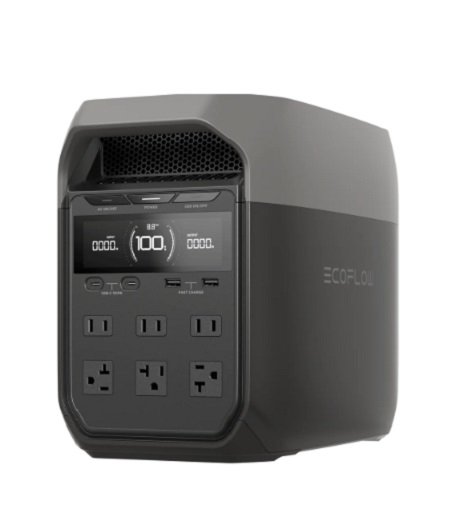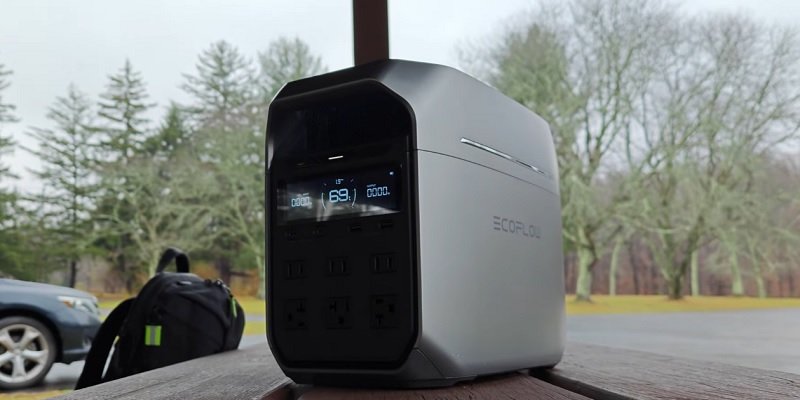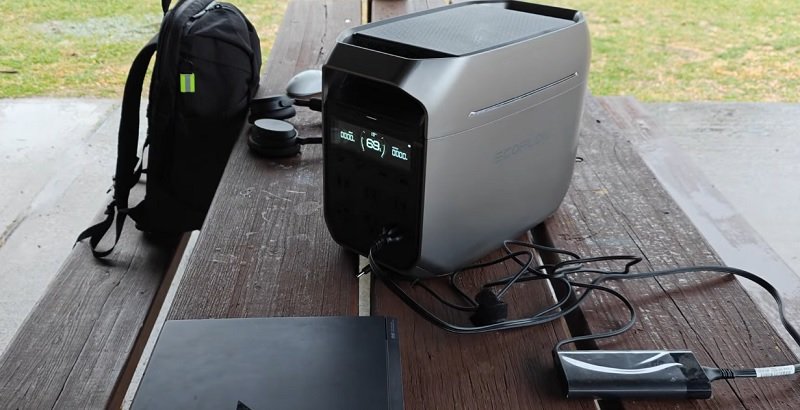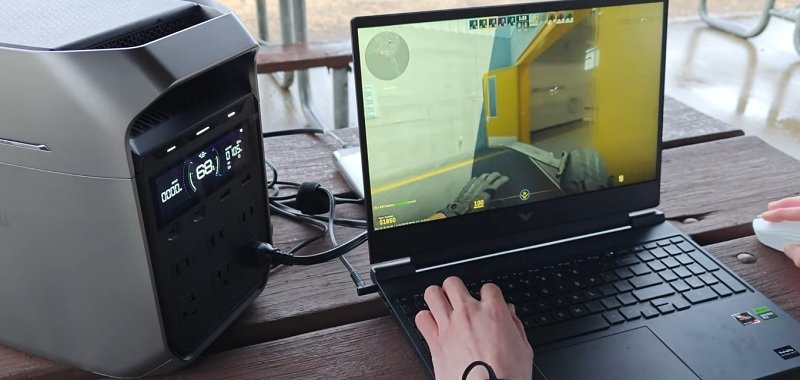Disclosure: This post contains affiliate links and I will be compensated if you make a purchase after clicking through my links. Learn More
We’ve been putting the EcoFlow Delta 3 through its paces, and this portable power station is a real standout. It’s smaller than its Pro sibling but still packs a punch, perfect for weekend camping trips, home emergencies, or powering tools on a job site.
With a sleek look, solid battery capacity, and plenty of charging options, it handles everything from laptops to small appliances with ease. Its size and weight might still challenge some users, though. Let’s dive into our experience, explore its features, and see if the EcoFlow Delta 3 fits your power needs.

What Is the EcoFlow Delta 3? A Review of Its Capabilities
The EcoFlow Delta 3 is a portable power station built to deliver reliable energy for homes, outdoor adventures, or small work sites. It comes with a 1,024Wh lithium iron phosphate (LiFePO4) battery, capable of running devices like a mini fridge, a CPAP machine, or even a coffee maker.
It’s a quieter, greener alternative to gas generators, offering multiple outlets and app-controlled features. You can even expand its capacity to 2,048Wh by adding an extra battery for longer runtimes.
Our first encounter with the Delta 3 came during a weekend getaway in a remote cabin. The thought of keeping our phones, a small cooler, and some lights powered without a loud generator was exciting. With recent power outages in our neighborhood, we also wanted to test its home backup potential. It performed well, but it’s not flawless, and we’ll share the full scoop below.
Design and Build: Portable but Solid
The EcoFlow Delta 3 has a modern, compact design that looks sharp. Its dark gray shell with smooth edges feels sturdy yet stylish, almost like a high-tech toolbox. Measuring 15.7 x 8.0 x 11.2 inches and weighing 27.6 pounds, it’s easier to move than larger models but still hefty for one person to carry long distances.
EcoFlow added ergonomic handles, which helped when we shifted it from our car to a campsite, but it’s not something you’d want to haul up a hill alone. Its IP65 rating means it shrugs off dust and splashes, which came in handy during a drizzly outdoor test.

The front panel features a clear LCD screen showing battery level, power usage, and estimated runtime. It’s bright and readable, even under direct sunlight. The ports are neatly arranged, with covers for USB and DC outlets to keep out dirt, though the AC outlets are exposed, which could be a concern in dusty environments. We plugged in a mix of devices, including phone chargers, a fan, and a blender, and found the layout intuitive and easy to use.
Power and Performance: Small Size, Big Output
The Delta 3 delivers a 1,800W output (3,600W with X-Boost), supporting both 120V appliances and smaller devices. It can power a 1,200W microwave, a 1,000W space heater, or a 600W projector without breaking a sweat. We tested it with a 1,000W kettle, a 500W mini fridge, and two phone chargers simultaneously, totaling around 1,700W. The unit ran smoothly, and the fan only kicked in noticeably at higher loads, staying quieter than expected at around 30dB.
Its 1,024Wh battery can keep a laptop charged for days or a small fridge running for 8-10 hours. During a brief power outage at home, it kept our Wi-Fi, a lamp, and a laptop going for 5 hours with 45% battery remaining. The 10ms switch-over makes it a solid UPS for sensitive electronics like computers. We also linked it to a transfer switch for home use, and it seamlessly took over when the power cut out.
Out in the field, we used it to power a projector and speakers for an outdoor movie night. The 30A Anderson port was great for connecting directly to our camping gear. If you need more capacity, adding an extra battery doubles it to 2,048Wh, which could run a small RV setup for a day or two.
Charging Options: Quick and Versatile
The Delta 3 shines with its charging flexibility. It supports multiple methods, including:
- AC Wall Outlet: 1,800W (120V), charging from 0% to 80% in about 45 minutes.
- Solar Panels: Up to 800W, fully charging in 2-4 hours with two 400W panels.
- Car Charging: 12V, taking around 10-12 hours.
- USB-C Input: 100W, slower but handy for topping up.
- EcoFlow Smart Generator: For backup charging in extended outages.
We charged it via a wall outlet in our garage, hitting 80% in under an hour. During our cabin trip, we used a single 400W solar panel, and it charged fully in about 3.5 hours on a sunny day. Combining AC and solar inputs can push charging speeds to 2,400W, which is great for quick turnarounds. The unit stayed cool during charging, thanks to its X-Cool system, which monitors temperature and safety metrics. We avoided constant fast charging to extend battery life, as it can stress any battery over time.
Smart Features and App Control
The Delta 3 pairs with the EcoFlow app, letting you control it via Bluetooth or Wi-Fi. You can check power levels, toggle outlets, or set charging schedules from your phone. We used the app to monitor usage while relaxing at our campsite, and it was a breeze to adjust settings without getting up. The app also supports firmware updates, which fixed a minor display flicker we noticed early on.
Scheduling charging for off-peak hours saved us some energy costs during home testing. The app integrates with other EcoFlow gear, like their portable AC units, making it a hub for multiple devices. The only downside? Bluetooth range drops off beyond 30 feet, so Wi-Fi is better for remote control.

EcoFlow Delta 3 Specifications
Here’s a snapshot of the Delta 3’s key specs:
- Battery Capacity: 1,024Wh (expandable to 2,048Wh)
- Output: 1,800W (3,600W with X-Boost), 120V
- Outlets: 6x 120V AC, 2x USB-C, 2x USB-A, 2x 12V DC, 1x 30A Anderson
- Charging Input: Up to 2,400W (AC, solar, etc.)
- Weight: 27.6 lbs (12.5 kg)
- Dimensions: 15.7 x 8.0 x 11.2 inches
- Battery Type: LiFePO4 (3,000+ cycles to 80% capacity)
- Warranty: 5 years
- Noise Level: ~30dB under 1,500W load
- IP Rating: IP65 (dustproof and water-resistant)
Pros and Cons of EcoFlow Delta 3
Pros:
- 1,024Wh battery powers small appliances for hours.
- Fast charging (0-80% in ~45 minutes) with solar, AC, and more.
- Quiet (~30dB) for indoor or outdoor use.
- App control makes monitoring and adjustments simple.
- IP65 rating ensures durability in tough conditions.
- Expandable capacity for longer runtimes.
Cons:
- Exposed AC outlets could collect dust or debris.
- No 240V support, limiting use with heavy appliances.
Real-World Testing: How It Held Up
We tested the Delta 3 in three settings: home backup, a camping trip, and a small DIY project. At home, we hooked it up to a transfer switch during a planned outage. It powered our router, a desk lamp, and a laptop for 5 hours, with plenty of battery left. The quick switch-over kept our devices running smoothly, which was great for staying connected.

During our cabin getaway, we ran a small cooler, phone chargers, and LED lights. The Anderson port made connecting our gear straightforward, and the quiet operation didn’t disturb the peaceful vibe. Solar charging with a 400W panel worked well, though we had to reposition it to catch full sun. Moving the unit around was manageable but required some effort over uneven ground.
For a friend’s backyard shed build, we used it to power a drill and a small saw. It handled the 1,500W load without issue, and the lack of generator noise was a big win. The only hassle was repositioning it to avoid sawdust near the AC outlets, as they lack covers.
We heard about a rare case where a user’s unit overheated during heavy use, but EcoFlow’s support resolved it quickly under warranty. Our unit ran flawlessly, but it’s a reminder to follow usage guidelines.
Who Should Get It?
The Delta 3 is perfect for those needing reliable power for smaller setups. It’s great for campers, homeowners in outage-prone areas, or DIYers on job sites. It can run a mini fridge, CPAP machine, or power tools for hours. If you only need to charge phones or small gadgets, a lighter unit like the EcoFlow River 2 might suffice. It’s not ideal for apartments with lots of stairs due to its weight or for powering heavy 240V appliances.
Comparing to Competitors
The Delta 3 faces off against models like the Jackery Explorer 1000 Plus (1,264Wh, 2,000W) and Anker Solix C1000 (1,056Wh, 1,800W). The Jackery is lighter (29 lbs) but has a lower solar input (600W vs. 800W). The Anker matches the Delta 3’s output but lacks the same app polish and charging versatility. We’ve tested Jackery units for lighter tasks, but the Delta 3’s faster charging and expandability give it an edge for more demanding needs.
Comparing to Delta 3 Plus
The EcoFlow Delta 3 Plus is a close sibling to the Delta 3, with a few tweaks that boost its versatility for tech-savvy users. Here’s how they differ in key features.
| Feature | EcoFlow Delta 3 | EcoFlow Delta 3 Plus |
|---|---|---|
| USB-A Fast Charging | 2x18W | 2x36W |
| USB-C Output | 2x100W | 2x140W |
| Solar Charging Time | 90 minutes (500W input) | 70 minutes (500W input) |
| NAS Server Support | Not supported | Supported |
Ready to power up your adventures or home backup? Check out the EcoFlow Delta 3 or Delta 3 Plus today and grab the one that fits your needs!
Our Verdict
Our EcoFlow Delta 3 Review proves it’s a compact yet powerful solution for many scenarios. It’s dependable, quiet, and versatile, ideal for camping, home backup, or small projects. The quick charging, solid capacity, and app control make it stand out, and expandability adds future-proofing. Sure, it’s not the lightest, but its performance makes up for it.
We loved how the EcoFlow Delta 3 kept our devices humming, from a cooler in the woods to tools in the backyard. Its sleek design and durability add a premium feel. If you need a portable power station for small to medium loads, this is a great choice. Just plan to have a buddy for longer hauls.

FAQs: EcoFlow Delta 3 Review
Can the EcoFlow Delta 3 power a fridge?
Yes, it can run a small fridge (500-700W) for 8-10 hours with its 1,024Wh battery. Connect it to a transfer switch for seamless home backup during outages.
How fast does the Delta 3 charge?
It charges to 80% in about 45 minutes via a 120V wall outlet. Solar charging with a 400W panel takes 2-4 hours, depending on sunlight.
Is it safe for indoor use?
Yes, its LiFePO4 battery is stable, and the X-Cool system ensures safety. It’s quiet (~30dB) and produces no fumes, perfect for indoor settings.
Can it power an RV camping setup?
Yes, it runs small RV appliances like lights or a cooler via the 30A Anderson port. Expand to 2,048Wh for longer camping trips.
How long does the EcoFlow Delta 3 battery last on a single charge?
Runtime varies by connected devices. LED lights run 50+ hours, laptops charge 8-12 times, and small refrigerators operate 6-10 hours. Mixed usage typically provides 8-20 hours depending on power consumption.
Does the EcoFlow Delta 3 work with any solar panels?
The Delta 3 accepts most solar panels with proper voltage specifications. EcoFlow panels optimize performance, but third-party panels work with appropriate connectors and voltage ranges between 11-60V DC.
How loud is the Delta 3 during operation and charging?
Fan noise ranges from nearly silent during light loads to moderate during heavy use or fast charging. Typical operation stays below 45 decibels, quieter than most household appliances.
How Long Does Ecoflow Delta Pro 3 Last?
The EcoFlow Delta Pro 3 battery can last up to 3,500 cycles, maintaining 80% capacity. This translates to about 10 years with daily use. The lifespan depends on usage, charging habits, and environmental conditions. Always follow the manufacturer’s guidelines for optimal performance and longevity.


